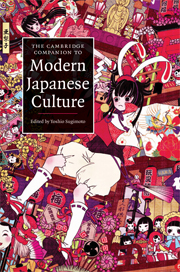Book contents
- Frontmatter
- ‘Japanese culture’: An overview
- 1 Concepts of Japan, Japanese culture and the Japanese
- 2 Japan’s emic conceptions
- 3 Language
- 4 Family culture
- 5 School culture
- 6 Work culture
- 7 Technological culture
- 8 Religious culture
- 9 Political culture
- 10 Buraku culture
- 11 Literary culture
- 12 Popular leisure
- 13 Manga, anime and visual art culture
- 14 Music culture
- 15 Housing culture
- 16 Food culture
- 17 Sports culture
- 18 Globalisation and cultural nationalism
- 19 Exporting Japan’s culture: From management style to manga
- Consolidated list of references
- Index
19 - Exporting Japan’s culture: From management style to manga
Published online by Cambridge University Press: 28 January 2010
- Frontmatter
- ‘Japanese culture’: An overview
- 1 Concepts of Japan, Japanese culture and the Japanese
- 2 Japan’s emic conceptions
- 3 Language
- 4 Family culture
- 5 School culture
- 6 Work culture
- 7 Technological culture
- 8 Religious culture
- 9 Political culture
- 10 Buraku culture
- 11 Literary culture
- 12 Popular leisure
- 13 Manga, anime and visual art culture
- 14 Music culture
- 15 Housing culture
- 16 Food culture
- 17 Sports culture
- 18 Globalisation and cultural nationalism
- 19 Exporting Japan’s culture: From management style to manga
- Consolidated list of references
- Index
Summary
For well over a century Japan has been exporting aspects of its culture. Toward the end of the 19th century, World Fairs in Paris and elsewhere offered Japan an early opportunity to take that which was 'Japanesque' to the Western world. The first half of the 20th century saw Japanese culture - especially the Japanese language, various technologies and ideas about architecture, archaeology, infrastructure and how to run government - disseminated throughout the Korean Peninsula, Taiwan and large parts of China. In the early years following the Second World War, overseas interest in Japan's martial arts and, not unrelated, in Zen Buddhism emerged and came to have a marked impact abroad on philosophy, poetry, film and the arts. A half century later, Brown noted that anime's global popularity had resulted in Japan having an added presence in global markets, one which is as much cultural as it is economic. Over 25 years earlier Vogel's volume on learning from Japan came to symbolise a new way of thinking about Japan. In drawing attention to Japan's across-the-board successes in creating a society of highly motivated citizens, Vogel argued that Americans should take a proactive interest in reversing the commonly accepted pattern for culture to flow 'from the West to the rest'.
- Type
- Chapter
- Information
- The Cambridge Companion to Modern Japanese Culture , pp. 352 - 368Publisher: Cambridge University PressPrint publication year: 2009
- 3
- Cited by



